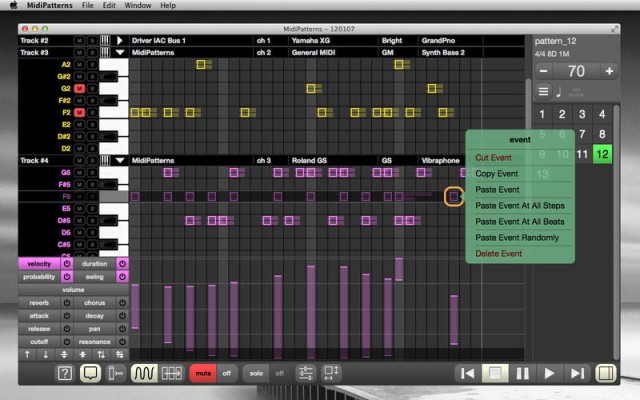
Developer Amedeo Farello has released MidiPatterns 2 – a major update to the multitrack, pattern-oriented, MIDI step sequencer for OS X.
You can use MidiPatterns as a simple drum machine, or to handle complex multi-timbral, polyphonic scores, controlling multiple hardware and software synthesizers at once.
Here’s what’s new in MidiPatterns 2.0:
- patterns now have an accurate time signature, a number of subdivisions per beat and a number of measures
- “songs” have become “sequences” and a new “Multiple Sequences” in-app purchase allows to have more than one per document; sequences can be switched just like patterns during playback
- a new “Customizable Modulations” in-app purchase allows to assign any midi controller to the 8 standard predefined modulations
- completely revised and streamlined interface, new sequences editor
- powerful, interactive quick help mode
- tap tempo function
- metronome precount and sound options
- virtual input and output MIDI devices
- variable score grid size
- improved midi import and export, with optional normalization of notes velocity during import
- tracks can now have a user defined name
- user defined middle C convention
- overlays mode to access contextual menus
- new Add Pattern To Current Sequence, Apply Tempo To All Patterns, Expand All Tracks, Collapse All Tracks, Clear Pattern’s Content For Track commands
- midi device loops check
- a double click resets sliders to default values
MidiPatterns is available now for US $11.99 in the Mac App Store. An iOS version is also available.
If you’ve used MidiPatterns, leave a comment and let us know what you think of it!

No transposing?
Looks cool but I wish it had infinite pattern length. Working with pages of steps is not the easiest way to keep track of long progressions and melodies.
This is pretty damn good on IOS. The labeled piano roll and the help overlays are a nice touch. In just a few minutes of messing around, my opinion is that it has a better look and feel than both MIDI Sequencer and Genome in that everything is in front of you on one main screen via slide-out and pull-down menus.
IAP for the IOS version is $9 for unlimited tracks/patterns with MIDI Import/Export, $11 if you also want multiple sequences.
No video?
Could be pretty amazing. I was kind of drunk when I tried it…so it was probably me but I couldn’t figure out how to change the length of notes? Seems like that should be something that’s easy to do, no? And…doesn’t Xynthesizer do multiple sequences for free? It has MIDI channel mapping for each octave I think..and it’s very easy to use. What makes this better? I also like MIDIsequencer but confess I haven’t used it much yet. Thought it was easy to use and a lot of easy control over note ornamentation , scales, and chords. Worked well with my hardware too.
I was perfectly sober and had a hard time to figure it out.The length of the notes is set as a modulation…by selecting each note and tapping on two tiny arrows on the bottom left corner…Far from ideal for a touch screen. It’s not bad, but iOS amazingly still lacks the definitive piano-roll, pattern-based sequencer, since Genome has this weird way of sequencing patterns (is not even easy to duplicate them), and, well, Gadget has no MIDI out. Yamaha’s Mobile sequencer -forget the internal sounds- is maybe the best one after all -and StepPolyArp, not being a truly sequencer, is better than any of them.
After selecting the score row you want to modify, press and hold one of the bars until it get surrounded by an orange contour. When in this mode, you can drag around and modify other sliders. Autoscroll is also supported.
Oh man, thanks for pointing that out. That really makes a big difference. Sorry if I didn’t take my time to read everything in the help screen. I’m having a great time right now sequencing BS16i and I’m totally going to use it with my hardware synths. I love the minimum-maximum value for modulation, the swing per note and the probability thing. I may have judged it prematurely, it’s looking pretty great to me right now. I’m not going to make any suggestion before getting deeper in it…
Tony Saunders of MIDISequencer is working on something that will probably be more the definitive piano-roll/pattern-based sequencer you are expecting. It’s been under development for a while now